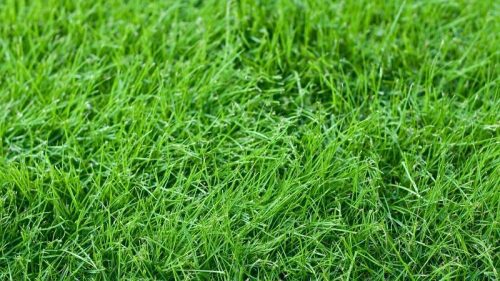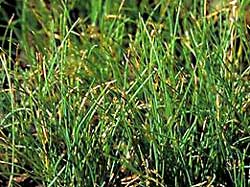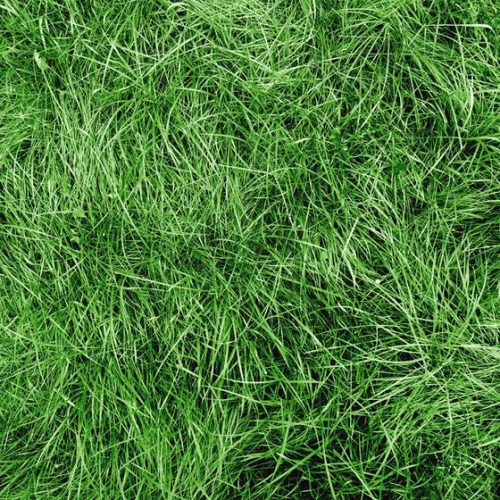Todo lo que debe saber sobre la hierba festuca - [Guía completa]
Possessing the ability to stay green all year long, Fescue Grass is one of the most desirable type of grass for homes in the United States and Canada. They are adaptable to various weather conditions and can withstand both – cold and shaded environment.
In fact, many of the fescues look striking in interior pots. They are easy to grow as well and require limited care.
In this guide, I have covered all the necessary information you need to know about the fescue, so you can enjoy an attractive landscape year round.
Fescue Grass Types
There are several varieties of the fescue grass that differ in appearance and characteristics. However, they all grow in bunches and rather than spreading out – they produce vertical off-shoots of glossy grass.
Tall Fescue Grass

The tall variety is the most popular type of fescue turf. It has long, thin blades that are coarse and dense. It is the most tolerant of heavy foot traffic, making it an ideal landscape for home lawns, sporting grounds, parks, and commercial areas such as hospitals.
The tall fescue grass is the best adapted to growing conditions in the transition zone. This is the broad area that runs from the East to the West of the USA. It is compatible for both – full sun and partial shade growing.
Grower’s Tip: Sow tall fescue grass seeds in heavier soils with a lot of organic matter for fast growth.
Hard Fescue

When it comes to appearance, the hard fescue is distinguished by its bluish-green coloring. It has the ability to stay green longer than others as well – with minimal maintenance. They are typically grown in Northern regions and areas with higher elevation.
Grower’s Tip: Hard fescue is a slow growing grass and does not require frequent cutting/mowing.
Creeping Red Fescue Grass

The cool season grass has fine blades of deep green color that grow sideways underground. It is very shade tolerant when compared to other cool season grasses and thrives well in the northern regions.
Due to its ability to grow rapidly, the creeping red fescue grass is common along road sides, erosion sites, and golf courses. The creeping red fescue has low fertilization and irrigation requirements.
Grower’s Tip: Sow the red fescue in areas with damaged turf or bare spots to fill the area fast.
Chewing Fescue Grass

Similar to the tall fescue, the chewing grass grows upright with a fine texture. It grows well in shaded areas and is drought resistance, perfect for indoor gardens.
This type of fine fescue grass grows well in sandy soils and is common in northern USA and Canada.
Grower’s Tip: The chewing fescue cannot tolerate high traffic so, it’s best to keep them in areas with minimal footfall. You can also grow them in containers and pots for an attractive display.
Sheep’s Fescue

Found in acidic grounds and mountain pastures, the sheep’s fescue is a cool season grass of blue-green color. It grows 16-inch tall and has a dense tuft.
It is common throughout the UK and East Asia.
Grower’s Tip: As the name implies, this type of fescue is a favorite grazing food of sheep’s.
How to Plant Fescue Grass
Starting your fine fescue lawn is easy with proper preparation. Ideally, we suggest choosing the autumn months for germination when the high temperatures are maximum 80.
Choose the Seed

When choosing fescue grass seed, make sure the plant blend is of high quality and purchased from reputable source.
Ideally, the germination rate should be lower than 80% while the crop, weed, and inert matter should be close to 0.00%. These rates are all indicated on the labels when you buy grass seeds.
Planting rates for the seeds vary between the different grass types. For tall fescues, 10 lbs. per 1,000 sq. ft. should be planted. However, other varieties of fescue have smaller seeds and require 5 lbs. per 1,000 sq. ft.
Check out the seed chart for other types of grass aquí.
Preparing the Soil
A general gardening rule is that the healthier your soil is, the healthier the grass will grow. Soil that is well-structured has a better ability to absorb water and nutrients. This also encourages the fescue’s root to grow deeper and have better access to the required component.
Test the soil to check if it’s acidic or alkaline with a DIY pH checking kit. Fescue grass prefers acidic soil with pH levels between 5.6 and 7. Having the soil levels at optimal numbers will ensure the availability of nutrients to the plant – allowing it to thrive.
However, if your soil kit indicates too much acid (pH 6 or lower), add lime to reach the target pH levels. On the other hand, if the alkaline levels (pH 7 and higher) are recorded, work in granular gypsum to the soil.
But note that both – lime and gypsum take 2 -3 months to react. The method can be repeated until the soil reaches the required level of pH – so make sure to schedule this time in your grass planting agenda.
If the ground chosen for your landscape is uneven, you may need to till the land as well. This process would also help breakup the soil while encouraging better water absorption and root growth.
Laying the Seed
Once you are satisfied with the condition of soil, spread out the seeds evenly on the ground. Many people choose to cover the seeds after planting as it helps retain moisture. If you wish to do the same, cover them with peat moss or fluffy top soil of around ¼ inch thickness.
Water the seeds gently until they began to sprout. You can decrease the water frequency as the grass starts to grow.
Avoid mowing the grass for at least 4 weeks from the planting time. Fertilizers are also recommended after 10 weeks of planting.
Tall Fescue Lawn Care and Maintenance

Now that you have a newly established piece of turf, make sure to offer them proper care so they stay green all year long.
Mowing
Ideally, the fine fescue grass blade should be kept around 2 – 3 inches long. Mow the lawn every 2 weeks. However, you may need to increase the timing to once a week in the spring months when the grass growth rate is at its peak.
When mowing the fescue – or any other grass, always remember the 1/3 rule. This means that you should never cut more than 1/3 of the grass blade as it may cause the fescue to become stressed.
Riego
The fescue benefits from a weekly watering session of 1 inch. When watering, make sure to wet the soil at a depth of 4 inches.
Try to water in the morning. This allows the soil to absorb maximum moisture. It also prevents grass burning.
Fertilizante
All fescue grass types are known for their non-fussiness. However, adding fertilizers to the soil can help them grow healthier, by making up for the missing nutrients.
Apply a nitrogen-based fertilizer once or twice a year. For a 1,000 sq. ft. yard, you will need around 3 pounds of fertilizer.
The best time to fertilize is during the fall and spring months. Avoid fertilizing in the warmer months. It is also a good idea to aerate the lawn before you fertilize.
Lawn Overseeding
To keep your lawn healthy and vigorous all year round, we recommend overseeding the area annually – preferably during the autumn season. This process will also help fill in any bare patches that have developed with time and use.
To overseed a fescue lawn:
- Prepare the area by running a soil test to check the pH levels of the soil.
- Mow the lawn at around 1 ½ inches.
- Rake out the debris and vegetation.
- Aerate the soil to improve seed germination.
- Spread out the seeds evenly over the entire area.
- Water the lawn immediately after planting the seeds – and keep watering daily until the seeds start germinating (2 weeks).
- Gradually decrease the watering to once a week after the grass starts growing.
With these tips, you will see a lush, green carpet of thick grass growing in about 5 – 6 weeks.
Fescue Weed and Disease

The fescue is susceptible to some diseases and weed problems that are common in cool-season grass. But this is no reason to panic as most of them resolve with changes in weather and some extra care.
Weed Control
Fescue lawns often weaken during the summer months, giving place for the weed to thrive.
Apply pre-emergent weed controls twice a year (preferably once in the spring) to kill immature weeds before they have a chance to germinate. However, avoid applying the herbicide if you are planning to overseed the lawn.
You will need a post-emergent herbicide if weeds are already present in the garden. Be sure to look for one that is labeled specifically for tall fescue lawn care.
Water the garden thoroughly after each application of weed control.
Enfermedades
Fungal diseases occasionally do appear in the fescue. They are usually a result of accumulated water in the roots during the summer months. In most cases, the problem usually fades away along with weather changes.
Unfortunately, the fungal diseases are usually difficult to identify in a fescue grass. Our best advice is to take a detailed look at the grass every couple of days for any abnormalities – such as brown or damaged patches of grass.
If you find the damaged turf of grass to be expanding, spray a fungicide labeled for the fescue every 15 days – until the disease diminishes.
Plagas
The most common inhabitants of your fescue lawn are crickets, grasshopper, worms, beetles, and millipedes. They usually don’t harm the grass – and thankfully, the fescue grows very fast so there is no need to worry.
But there are some insects that may create a problem for your beautiful landscape. The best way to prevent a troubled-lawn is to apply an insecticide once a year – in late July or early august.
Make sure to use a pest control treatment, specifically formulated for the fescue.
Animals
The fescue is a pet-friendly type of grass and generally safe for your furry companions.
However, dog waste can destroy your garden very quickly. Avoid letting your pet relieve itself on the turf. In case of accidents, make sure to water the area thoroughly so the grass recovers.
¡Listo para crecer!

Fescue grass is a popular grass, renowned for its lush appearance. And with these tips, we are sure you can maintain your lawn to remain healthy and vibrant all year round!







